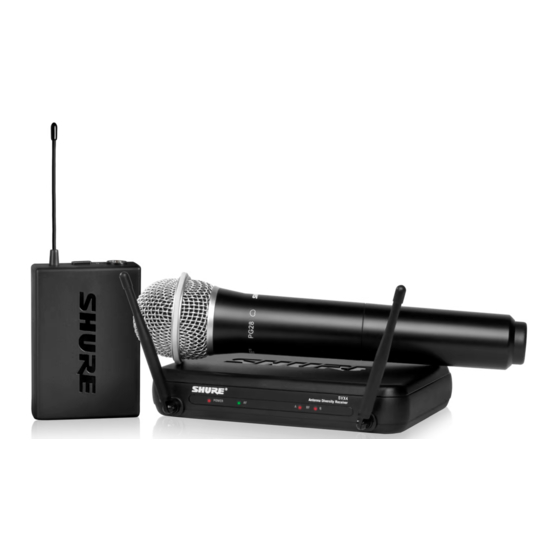
Summary of Contents for Shure SVX
- Page 1 Wireless System Online user guide for SVX wireless system. Version: 1.0 (2022-A)
-
Page 2: Table Of Contents
Shure Incorporated Table of Contents Squelch SVX Wireless System Low Battery Indicator Color ID Rings SAFETY PRECAUTIONS Getting Good Sound Quick Setup Correct Microphone Placement Shure SVX Wireless Wearing the Headworn Microphone Wearing the Bodypack Transmitter Receiver Transmitter Wireless Tips to Improve System Performance... -
Page 3: Svx Wireless System
Shure Incorporated SVX Wireless System SAFETY PRECAUTIONS The possible results of incorrect use are marked by one of the two symbols—"WARNING" and "CAUTION"—depending on the imminence of the danger and the severity of the damage. WARNING: Ignoring these warnings may cause severe injury or death as a result of incorrect operation. CAUTION: Ignoring these cautions may cause moderate injury or property damage as a result of incor rect operation. WARNING If water or other foreign objects enter the inside of the device, fire or electric shock may result. -
Page 4: Quick Setup
Congratulations on purchasing your SVX Wireless system from Shure. Shure professional audio products deliver legendary sound quality, stage-proven durability and hassle-free setup. The SVX Wireless System comes with your choice of lavalier, handheld, or headset microphone making it an ideal choice for presentation, karaoke performance, aerobics/fitness instruction or other applications where the freedom of wireless is desired. -
Page 5: Receiver
Shure Incorporated Receiver KCX4 KCX88 ① Power LED light ② Audio Frequency LED light ③ Radio Frequency Diversity lights ④ Balanced output (XLR connector) ⑤ Unbalanced output (6.35mm connector) ⑥ Audio output level (line/mic) switch ⑦ Channel selection dial ⑧ Squelch dial ⑨... -
Page 6: System Components
⑧ Radio Frequency (RF) level switch ⑨ Antenna ⑩ Color ID rings ⑪ Anti-roll ring ⑫ Power LED light System Components All Systems • SVX Receiver • PS24 Power Supply • Channel Selector Tool • 2 AA batteries Handheld Transmitter •... -
Page 7: Connecting To A Sound System
Shure Incorporated Insert 2 AA batteries into the transmitter. Hold the power button for two seconds to turn on. Connecting to a Sound System Connect the balanced XLR output on the receiver to a MIC or LINE input. Set the LINE MIC switch accordingly. -
Page 8: Getting Good Sound
Shure Incorporated Getting Good Sound Correct Microphone Placement • Hold the microphone within 12 inches from the sound source. For a warmer sound with increased bass presence, move the microphone closer. • Do not cover grille with hand. Wearing the Headworn Microphone • Position the headworn microphone 13 mm (1/2 in.) from the corner of your mouth. • Position lavalier and headworn microphones so that clothing, jewelry, or other items do not bump or rub against the micro phone. 8/14... -
Page 9: Wearing The Bodypack Transmitter
Shure Incorporated Wearing the Bodypack Transmitter • Clip the transmitter to a belt or pocket. • For best results, the belt should be pressed against the base of the clip. Wireless Tips to Improve System Performance If you encounter wireless interference or dropouts, try the following suggestions: •... -
Page 10: Optional Accessories
WADRM Replacement Parts Channel Key 53A14226 Microphone Stand Adapter 95A14227 Power Supply PS24 See your local Shure distributor for assistance Frequency Range Frequency Range ( MHz ) Band 698 to 710 710 to 726 726 to 742 742 to 758... -
Page 11: Australia Warning For Wireless
Shure Incorporated Frequency Range ( MHz ) Band 794 to 806 806 to 810 925 to 937.5 925 to 932 558 to 570 NOTE: This Radio equipment is intended for use in musical professional entertainment and similar applications. This Radio apparatus may be capable of oper ating on some frequencies not authorized in your region. Please contact your national authority to obtain information on authorized frequencies and RF power levels for wireless microphone products. - Page 12 Shure Incorporated 18 m (60 ft) (Line of Sight) LO power mode Audio Frequency Response 50–15000 Hz (Note: Dependent on microphone type) Modulation FM, Ref. ±48 kHz deviation with 1 kHz tone Total Harmonic Distortion <0.5% Dynamic Range 90 dB, Aweighted, typical Operating Temperature Range -10°C (0°F) to 50°C (122°F) (Note: Battery characteristics may limit this range.) Transmitter Audio Polarity Positive pressure on microphone diaphragm produces positive voltage on pin 2 (with respect to pin 3 of XLR output) and the tip of the 6.35 mm (1/4-inch) output.
- Page 13 Shure Incorporated Power Requirements 2 "AA" size alkaline or rechargeable batteries Battery Life up to 10 hours SVX2 Handheld Transmitter Audio Input Level(maximum) −20 dBV Input Impedance 22 kΩ RF Output Power dependent on applicable country regulations 10 mWmaximum HI power mode 1 mWmaximum LO power mode Dimensions 254 mm X 51 mm dia. (10 X 2 in.)
- Page 14 Shure Incorporated Audio Output Level Ref. ±48 kHz deviation with 1 kHz tone XLR connectorinto 100 kΩ load −16 dBV 6.35 mm (1/4") connectorinto 100 kΩ load −22 dBV J9 Audio Output Level Ref. ±26 kHz deviation with 1 kHz tone XLR connectorinto 100 kΩ load −21 dBV...
















Need help?
Do you have a question about the SVX and is the answer not in the manual?
Questions and answers